Compound arm exercises are ideal for building arm mass quickly.
By working multiple muscle groups simultaneously, they allow you to train efficiently and handle maximally heavy weights, helping you build more muscle in less time.
In this article, you’ll learn the best compound movements for your triceps and biceps, a highly effective compound arm workout to help you build arm mass fast, and more.
What Is a Compound Arm Exercise?
A compound exercise is an exercise that trains multiple muscle groups simultaneously. In contrast, an isolation exercise is an exercise that trains just one muscle at a time.
Thus, a compound arm exercise is an exercise that trains several muscles, including the biceps or triceps.
Compound biceps exercises generally involve pulling a weight toward your torso. Conversely, compound triceps exercises typically involve pushing a weight away from your torso.
The 10 Best Compound Exercises for Arms
1. Close-Grip Bench Press
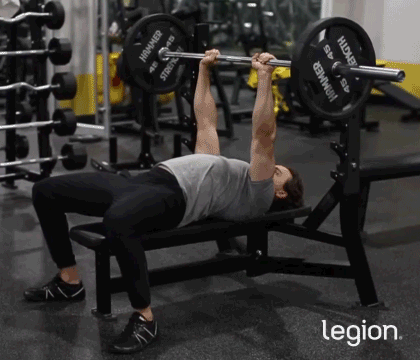
Muscle Worked: Triceps, pecs, and shoulders
Most weightlifters regard the close-grip bench press and the best compound triceps exercise because it allows you to train your entire triceps with heavy weights safely. What’s more, because it’s a barbell exercise, it makes implementing progressive overload simple.
2. Dip
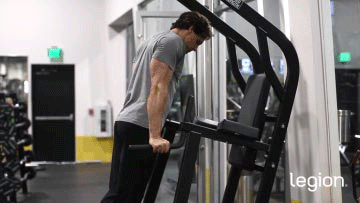
Muscle Worked: Triceps, pecs, and shoulders
The dip is a top-tier compound triceps exercise because it trains all three heads of the triceps, which means it’d ideal for adding overall mass to the back of your arms.
3. Diamond Push-up

Muscle Worked: Triceps, pecs, and shoulders
The diamond push-up allows you to train your entire triceps using only your body weight, making it a fantastic compound triceps exercise for people with limited access to gym equipment.
4. Neutral-Grip Dumbbell Press
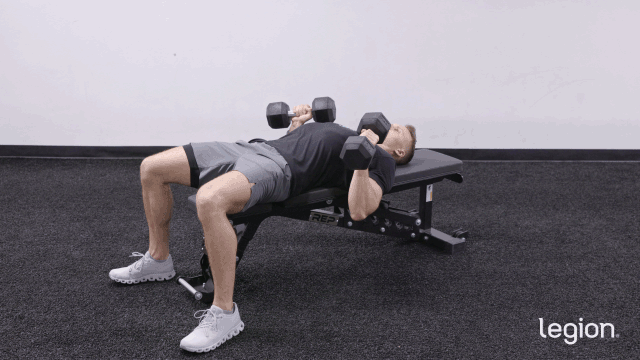
Muscle Worked: Triceps, pecs, and shoulders
The neutral-grip dumbbell bench press works your triceps much like the close-grip bench press, though many people find it easier on their shoulders. It also naturally places your elbows closer to your sides, which ensures your triceps do the lion’s share of the work.
However, the downside is that dumbbells are harder to control than a barbell. This usually means you can’t lift as much weight, which slightly limits how much strength and muscle you can build with this exercise.
5. Dumbbell Pullover

Muscle Worked: Triceps, pecs, and lats
While the dumbbell pullover doesn’t train the triceps through a full range of motion, it does place a lot of tension on them (the long head especially) when stretched, which makes it an effective exercise for gaining triceps mass.
6. Chin-up

Muscle Worked: Biceps, lats, mid and lower traps, and rhomboids
The chin-up is arguably the most effective compound exercise for biceps because it trains your biceps through their full range of motion, makes lifting progressively heavier weights practical and safe, and places your wrists in a supinated (palms facing you) position, which is important for building your biceps “peak.”
7. Pull-up
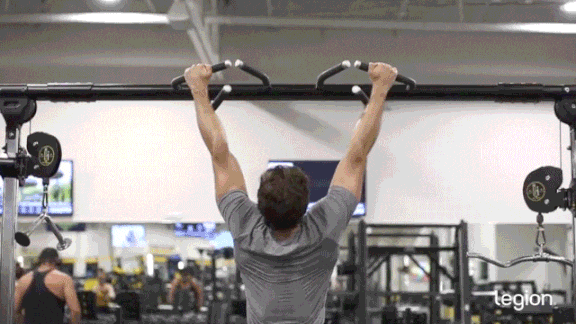
Muscle Worked: Biceps, lats, mid and lower traps, and rhomboids
Research shows that the pull-up is an outstanding compound biceps movement. It’s so effective for gaining mass because it trains the biceps through a long range of motion and is easy to progressively overload (with the help of a dip belt).
8. Neutral-Grip Pull-up
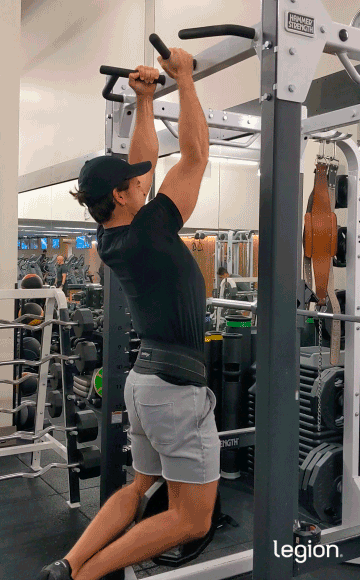
Muscle Worked: Biceps, brachialis, lats, mid and lower traps, and rhomboids
The neutral grip pull-up is a proven biceps builder. Because it involves a neutral grip, it also emphasizes the brachialis, a small muscle that helps to “push” your biceps peak higher.
9. Lat Pulldown
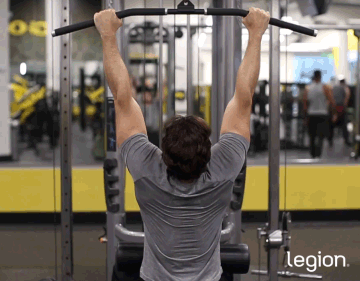
Muscle Worked: Biceps, lats, mid and lower traps, and rhomboids
The lat pulldown trains the biceps similarly to the pull-up, so you can use these compound biceps movements interchangeably.
10. Neutral-Grip Lat Pulldown
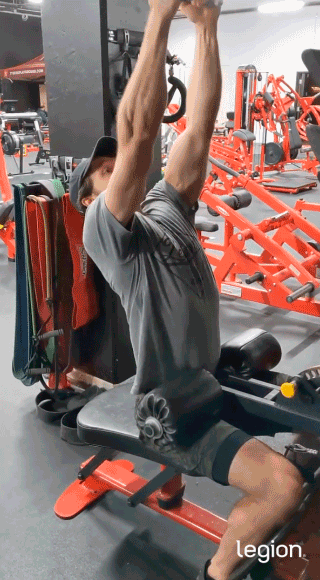
Muscle Worked: Biceps, brachialis, lats, mid and lower traps, and rhomboids
Like the neutral-grip pull-up, the neutral-grip lat pulldown emphasizes the brachialis more than most other compound biceps exercises, making it particularly effective for adding size to your “bis.”
The Benefits of Compound Arm Exercises
They’re time-efficient.
Compound exercises train multiple muscle groups simultaneously, allowing you to achieve the results of several isolation exercises in less time.
This means you can . . .
- Spend less time in the gym without sacrificing workout volume (sets), or,
- Do more overall volume in the same amount of time, which will likely help you gain more muscle and strength
They allow you to lift heavy weights.
Because compound exercises involve several muscle groups, they typically allow you to lift heavier weights than isolation exercises.
This means you can subject your muscle to higher amounts of tension, which is vital for gaining mass and strength.
Should You Only Train Your Arms with Compound Exercises?
Compound exercises are crucial for building arm mass and strength, but relying solely on them isn’t enough for optimal development.
While compound arm movements train your biceps and triceps effectively, research shows that doing additional arm isolation exercises leads to more balanced and complete muscle growth.
For example, studies show that “pulling” exercises like the lat pulldown are almost as effective as isolation exercises for building your biceps, but adding biceps isolation exercises to compound pulling exercises results in slightly more growth.
In other words, while biceps isolation exercises may not drastically boost biceps growth, they likely contribute significantly over time.
Similarly, while pressing exercises typically train the lateral and medial heads of the triceps, they don’t work the long head as effectively. To compensate, doing isolation exercises that emphasize the long head is essential for all-around triceps growth.
Moreover, isolation exercises allow you to train your arms even when other muscles are fatigued from compound movements, which makes training your arms with enough volume to grow more practical.
Therefore, the best approach for most is to spend around 70% of your arm training time on compound exercises and the remaining 30% on isolation exercises.
This keeps your training fresh, enjoyable, and engaging, gives your joints a rest from heavy compound weightlifting, and will likely cause more balanced arm growth.
The Best Compound Workout for Arms
This compound arm workout contains all the best exercises for training your biceps and triceps, as well as most other muscles in your upper body.
It also includes the perfect amount of volume to stimulate muscle growth without wearing you out.
For best results do this workout once weekly, and add some biceps and triceps isolation exercises to some of your other workouts during the week.
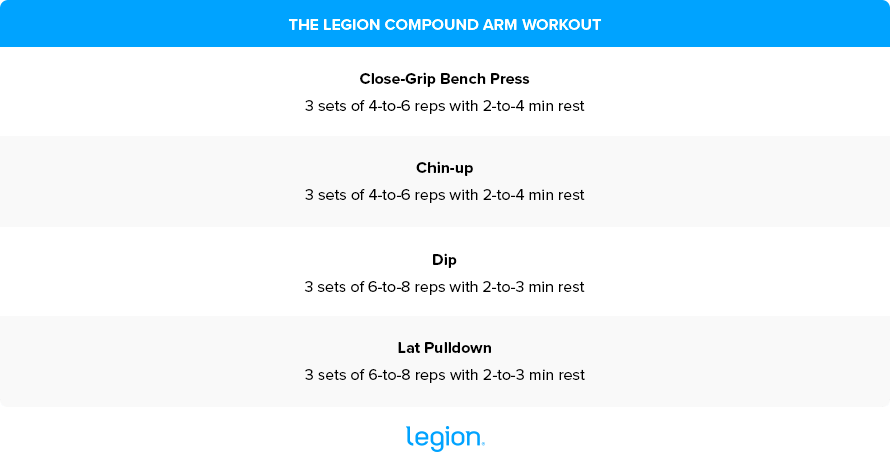
3 Tips for More Productive Compound Arm Workouts
1. End every set 1-to-2 reps shy of muscle failure.
To maximize muscle and strength gains in your compound arm workouts, you must take most of your sets within a rep or two of muscle failure.
Ask yourself at the end of each set, “If I had to, how many more reps could I have gotten with good form?” If the answer is more than two, increase the weight or reps to make your next set more challenging.
2. Once you hit the top of your rep range for one set, increase the weight.
If your workout calls for 4-to-6 reps of the close-grip bench press and you get 6 reps for a set, add 10 pounds to your next set.
If you manage 3 or fewer reps with the new weight, reduce the weight by 5 pounds to ensure you stay in the 4-to-6 rep range.
Follow this pattern of trying to add reps or weight to every exercise in every workout.
3. Take the right supplements.
The best supplements for maximizing arm growth are:
- Protein powder: Protein powder, such as whey or casein, provides your body with the nutrients needed to build muscle tissue and recover from workouts.
- Creatine: Creatine supplements, such as creatine monohydrate powder and gummies, boost muscle and strength gain, improve anaerobic endurance, and reduce muscle damage and soreness from your workouts.
- Pre-workout: A high-quality pre-workout enhances energy, mood, and focus, increases strength and endurance, and reduces fatigue.
(If you’d like even more specific advice about which supplements you should take to reach your health and fitness goals, take the Legion Supplement Finder Quiz, and in less than a minute, you’ll know exactly what supplements are right for you. Click here to check it out.)
Scientific References +
- Marcolin, Giuseppe, et al. “Selective Activation of Shoulder, Trunk, and Arm Muscles: A Comparative Analysis of Different Push-up Variants.” Journal of Athletic Training, vol. 50, no. 11, 1 Nov. 2015, pp. 1126–1132, meridian.allenpress.com/jat/article/50/11/1126/112538/Selective-Activation-of-Shoulder-Trunk-and-Arm, https://doi.org/10.4085/1062-6050-50.9.09.
- Kim, You-Sin, et al. “Effect of the Push-up Exercise at Different Palmar Width on Muscle Activities.” Journal of Physical Therapy Science, vol. 28, no. 2, 2016, pp. 446–449, https://doi.org/10.1589/jpts.28.446.
- Muyor, José M., et al. “Comparison of Electromyographic Activity during Barbell Pullover and Straight Arm Pulldown Exercises.” Applied Sciences, vol. 12, no. 21, 3 Nov. 2022, p. 11138, https://doi.org/10.3390/app122111138.
- Maeo, Sumiaki, et al. “Greater Hamstrings Muscle Hypertrophy but Similar Damage Protection after Training at Long versus Short Muscle Lengths.” Medicine & Science in Sports & Exercise, vol. 53, no. 4, 2 Oct. 2020, pp. 825–837, https://doi.org/10.1249/mss.0000000000002523.
- Jarrett, Claudius D., et al. “Anatomic and Biomechanical Analysis of the Short and Long Head Components of the Distal Biceps Tendon.” Journal of Shoulder and Elbow Surgery, vol. 21, no. 7, July 2012, pp. 942–948, https://doi.org/10.1016/j.jse.2011.04.030.
- Dickie, James A. , et al. Electromyographic Analysis of Muscle Activation during Pull-up Variations. Nov. 2016, www.researchgate.net/publication/311091421_Electromyographic_analysis_of_muscle_activation_during_pull-up_variations, http://dx.doi.org/10.1016/j.jelekin.2016.11.004.
- Gentil, Paulo, et al. “Effect of Adding Single-Joint Exercises to a Multi-Joint Exercise Resistance-Training Program on Strength and Hypertrophy in Untrained Subjects.” Applied Physiology, Nutrition, and Metabolism, vol. 38, no. 3, Mar. 2013, pp. 341–344, https://doi.org/10.1139/apnm-2012-0176. Accessed 9 Aug. 2019.
- Gentil, Paulo, et al. “Single vs. Multi-Joint Resistance Exercises: Effects on Muscle Strength and Hypertrophy.” Asian Journal of Sports Medicine, vol. 6, no. 1, 22 Mar. 2015, www.ncbi.nlm.nih.gov/pmc/articles/PMC4592763/, https://doi.org/10.5812/asjsm.24057.
- Brandão, Lucas, et al. “Varying the Order of Combinations of Single- and Multi-Joint Exercises Differentially Affects Resistance Training Adaptations.” Journal of Strength and Conditioning Research, vol. 34, no. 5, Mar. 2020, p. 1, https://doi.org/10.1519/jsc.0000000000003550.
- Stokes, Tanner, et al. “Recent Perspectives Regarding the Role of Dietary Protein for the Promotion of Muscle Hypertrophy with Resistance Exercise Training.” Nutrients, vol. 10, no. 2, 7 Feb. 2018, p. 180, www.mdpi.com/2072-6643/10/2/180/pdf.
- Jd, Branch. “Effect of Creatine Supplementation on Body Composition and Performance: A Meta-Analysis.” International Journal of Sport Nutrition and Exercise Metabolism, 1 June 2003, pubmed.ncbi.nlm.nih.gov/12945830/.
- Eckerson, Joan M., et al. “Effect of Creatine Phosphate Supplementation on Anaerobic Working Capacity and Body Weight after Two and Six Days of Loading in Men and Women.” The Journal of Strength and Conditioning Research, vol. 19, no. 4, 2005, p. 756, https://doi.org/10.1519/r-16924.1.
- Bassit, Reinaldo Abunasser, et al. “Effect of Short-Term Creatine Supplementation on Markers of Skeletal Muscle Damage after Strenuous Contractile Activity.” European Journal of Applied Physiology, vol. 108, no. 5, 3 Dec. 2009, pp. 945–955, https://doi.org/10.1007/s00421-009-1305-1.










